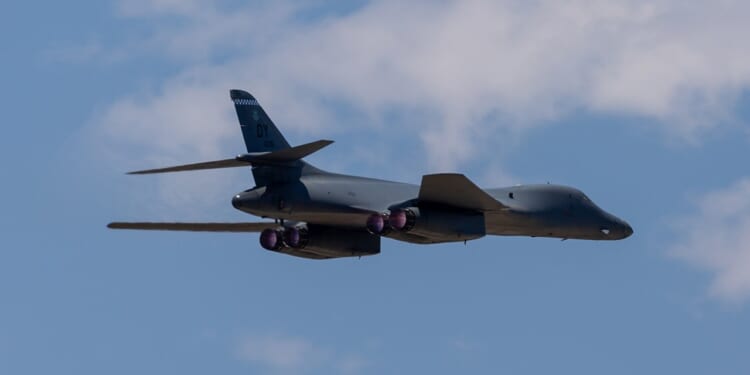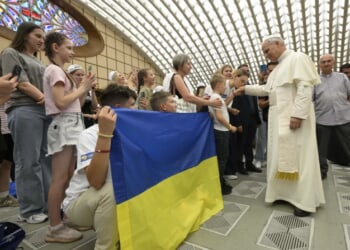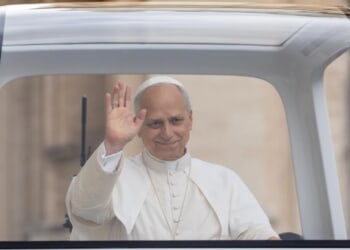The B-1 Lancers join at least eight US Navy warships and a submarine known to be operating near Venezuela—as well as previous flights from F-35 fighters and B-52 Stratofortress bombers.
A pair of United States Air Force Rockwell B-1B Lancer long-range, strategic heavy bombers made a flight near the coast of Venezuela on Thursday. It came just a week after three Boeing B-52 Stratofortress bombers were also tracked off the coast of the South American nation.
Flight tracking data showed that the Cold War-era Lancers flew from Dyess Air Force Base (AFB), Texas, one of the two facilities that support B-1B operations.
The B-1 Lancer’s Specifications
The United States Air Force currently operates 45 B-1B Lancers. The aircraft formally entered service 40 years ago as a nuclear bomber, but following the end of the Cold War, it has been restricted to carrying conventional weapons. It is highly unlikely that nuclear weapons would be used in any future conflict with Venezuela in any case.
- Year Introduced: 1985
- Number Built: 104 (45 in active service)
- Length: 146 ft (44.5 m)
- Wingspan: 79 ft (24.1 m)
- Weight:
- 190,000 lb (86,183 kg) empty
- 477,000 lb (216,364 kg) MTOW
- Engines: 4 x General Electric F101-GE-102 afterburning turbofan engines
- Top Speed: ~925 mph (~1,500 km/h, Mach 1.25) at altitude
- Range: 6,500 nmi (~7,500 mi, 12,000 km)
- Service Ceiling: 60,000 ft (18,000 m)
- Payload:
- Internal: 75,000 lb (34,019 kg)
- External: 50,000 lb (22,679 kg)
- Aircrew: 4 (aircraft commander, copilot, two weapon systems officers)
Trump Has Denied Sending B-1s to Venezuela
The Wall Street Journal was among the first news outlets to report the deployment of the bombers. On Thursday afternoon, however, President Donald Trump seemed to deny the reports when asked for commentary.
“No, that’s not accurate,” Trump said of the reports, following a Cabinet meeting in which discussions included efforts to confront the drug cartels that the administration maintains operate from Venezuela. “But we’re not happy with Venezuela for many reasons, drugs being one of them.” It is not clear what Trump believed to be inaccurate about the public reporting, which has been widely confirmed.
The B-1 Lancers near Venezuela join at least eight US Navy warships and a submarine known to be operating in the Caribbean. In addition, the United States Marine Corps has deployed Lockheed Martin F-35B Lightning II stealth fighters to Puerto Rico. Some of those aircraft escorted B-52 Stratofortress bombers during last week’s patrol flight near Venezuela.
The US military deployment is one of the largest in the region since the 1960s, Newsweek reported. The Trump administration has described Venezuelan President Nicolás Maduro as a “narcoterrorist” and has enacted a $50 million bounty for his arrest.
Is the United States Planning to Invade Venezuela?
Earlier in the week, Trump also told reporters that he has the “legal authority” to launch attacks on alleged drug-carrying boats. As of this week, there have been nine strikes on alleged drug-smuggling vessels, killing as many as 37 people.
Trump suggested strikes could be made on land as well.
“We will hit them very hard when they come in by land,” Trump told reporters in the Oval Office. “We’re totally prepared to do that. And we’ll probably go back to Congress and explain exactly what we’re doing when we come to the land.”
Secretary of Defense Pete Hegseth has also compared this crackdown to the War on Terror, analogizing Islamist militants to drug smugglers in terms of the threat they posed to the US homeland.
“Our message to these foreign terrorist organizations is we will treat you like we have treated al-Qaeda,” Hegseth also told reporters on Thursday at the White House. “We will find you, we will map your networks, we will hunt you down, and we will kill you.”
The B-1 Flights Were a Serious Show of Force
The B-1B Lancers that flew near Venezuela reportedly were within 50 miles of the South American nation’s coast. The aircraft, callsigns BARB21 and BARB22, were supported by KC-135 aerial refueling aircraft operating out of MacDill AFB, Florida.
The flight on Thursday was likely saber-rattling and a form of “gunboat diplomacy,” albeit with long-range bombers, but the message was the same. However, if ground strikes were to be carried out on targets in Venezuela, it could include a combination of missiles launched by the United States Navy and standoff weapons fired from aircraft like the B-1B.
“Any direct action against the US military might take against Venezuela could easily involve standoff strikes launched from B-1s, as well as other platforms,” The War Zone reported.
Thursday’s sortie of two B-1B Lancers follows a deployment of four more of the long-range bombers from Dyess AFB to Misawa Air Base, Japan, as part of the latest Bomber Task Force (BTF) mission.
The Lancers will likely carry out joint operations with the Japan Self-Defense Force (JSDF) and other US elements in the Far East. The JSDF’s large-scale, regional wargames kicked off on Monday and will run through the end of the month.
About the Author: Peter Suciu
Peter Suciu has contributed over 3,200 published pieces to more than four dozen magazines and websites over a 30-year career in journalism. He regularly writes about military hardware, firearms history, cybersecurity, politics, and international affairs. Peter is also a contributing writer for Forbes and Clearance Jobs. He is based in Michigan. You can follow him on Twitter: @PeterSuciu. You can email the author: [email protected].
Image: Wikimedia Commons.


















